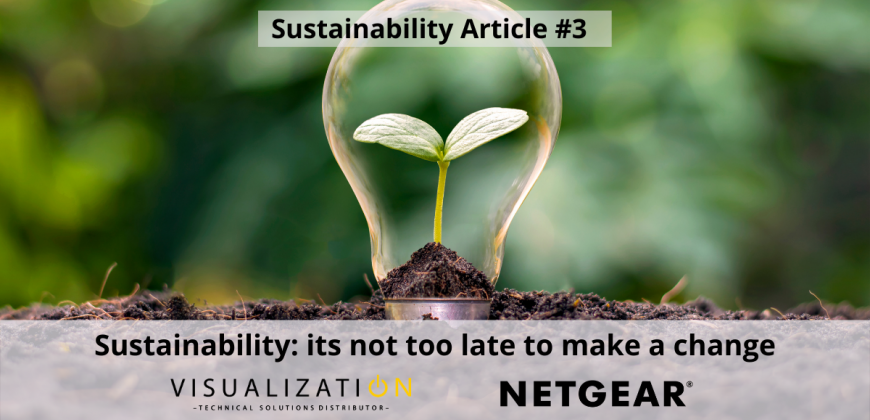Maidenhead, United Kingdom

Sustainable I, becomes Sustainable WE, in turn becoming Sustainable US
Sustainability: its not too late to make a change
This is the 3rd article in a series, written by either Richard Jonker of NETGEAR. The first article is called “Basic Sustainable Design-Best Practice”, written by Anna Bateman of Visualization and the second article is "Five trends in post-COVID conference room tech - and how to solve multiple hybrid working headaches" by Richard Jonker of NETGEAR.
The United Nations COP27 Climate change summit was held last week in Egypt, 30 years since the UNFCCC was adopted. and seven years since the Paris agreement was agreed at COP21.
During the summit it has been disclosed that global leaders have drastically failed to meet climate targets set.
The main mission for humanity is to keep the rise in global average temperatures to well below 2*C so as not to face a global catastrophe.
The latest assessment submitted by the UNFCCC shows that current commitments to NDCs will increase global emissions by 10.6% by 2030; this is in strong contrast to the 45% emission decrease needed to align with the 1.5*C pathway.
Under current pledges we are set to see an increase to 2.5*C by the end of the century causing immense damage to the environment, society and humanity as we know it.
Sustainability IS humanity’s problem; and we are the only ones who can effect change.
As conscious individuals, the only way forward is to start taking personal responsibility and accountability for Sustainability and the environment, with some out-of-the-box thinking,
Through innovation, initiative, and influence, how can we create the impact required individually and as a collective to cut carbon emissions and improve the climate outcome for future generations?
The very core of Sustainability through mainstream academia is taught as a balance of the three pillars, environment, social and economic, but with some careful dissecting of that theory it becomes obvious that the three pillars are not equal.
Without the environment there is no social and without the social there is no economic.
It can be daunting to change the mindset of the consumer. However, we are seeing the shift in consumer spending in recent social and economic research studies. More people are making sustainable choices.
The statistics show that, given the choice, 73% of consumers choose sustainable options, with a staggering 83% of millennials always choosing the sustainable option. When Gen Z and Gen Alpha start contributing to the economy, we’re bound to see even more positive change. We’ll see movement away from brands that are stuck in the past, and towards companies that are providing a clear choice for environmentally aware consumers.
So, is your company making the change now? Are you offering sustainable choices to your clients? If you’re not doing it, you can be sure that the competition is thinking about it. Let’s take the initiative to clients and show them how easy it is to make positive change.
A simple option could be to offer two quotes for client projects: one for your standard system, and the second a sustainable option including how much carbon your client will save.
Gartner has outlined Sustainability in 2023 as one of the
‘Top 10 Strategic Technology Trends’
Let’s look at what actions can we all take in Business to be more Sustainable:
1. Sustainability Policy
2. Allocate Sustainability Champions
3. Creating Sustainability Goals (meet quarterly to check progress and create the next set of Goals)
4. Educate staff on Sustainability
5. Create a Sustainable supplier database (grade your suppliers sustainability credentials)
6. Design Sustainable products and services (80% of carbon savings can be captured at the design stage)
7. Create a carbon efficiency database (track year on year carbon and ensure its decline)
8. Support environmental groups and schemes
Sustainability starts with our own actions. If we can adapt our way of thinking; motivate and influence ourselves to make sustainable choices and decisions, we are better placed to influence those around us to in turn make sustainable choices and decisions.
We have already discussed how the consumer mindset is changing, so we are already taking some initiative in our choices and in turn influencing the market and our sustainable impact.
So how can we as individuals take further responsibility and accountability to further influence and improve our sustainable mindset?
In 2016, I implemented a Human behaviour change scheme across a local authority estate. The scheme created 15% energy savings through simple campaigns that promoted simple changes, e.g., using the stairs instead of the lift; encouraging less printing and cutting down on the amount people cc’d into emails (each email using approx. 7g of carbon).
As they say, ‘Old habits die hard.’ Even with my awareness and experience in the field of Sustainability, I recently had to check my thinking. Whilst staying on the fourth floor of a London hotel, following my evening meal I entered the lobby and pressed for the lift. I then paused, and thought ‘what am I doing?’ I didn’t have any luggage to carry and surely, I could do with walking off the 2- course meal I’d just consumed. It was just habit and laziness that led me to press the lift button. So, I made the Sustainable choice and took the stairs.
Do we always make the Sustainable choice? Possibly not.
Should we always make the Sustainable choice? Absolutely.
Let’s say that when presented with a Sustainable choice, we make a positive decision 3 times out of 5. Even small changes can have a huge impact when everyone makes a positive choice.
So, let’s think about the day-to-day actions WE can implement to create our Sustainable impact?
1. Walking, Cycling, using public transport or Car sharing
2. Buying food with recyclable packaging
3. Switching off lighting and appliances when not in use
4. Choosing efficient products
5. Choosing recycled products
6. Minimising heating and cooling of building (heat / cool the individual)
7. Wash clothes at 30*C
8. Use the stairs instead of the lift
Let US use our opposable thumbs and conscious minds for positive creation taking individual responsibility and accountability, together making small steps to create the compounding effects required to support the healthy development of humanity, whilst supporting the very planet that allows our existence.
Further reading
https://www.trustedreviews.com/sustainability-technology-innovations
https://www.weforum.org/impact/net-zero-carbon-future-for-cities/
https://www.overshootday.org/newsroom/visuals/
https://www.who.int/health-topics/mental-health#tab=tab_1
Gartner’s top 10 strategic technology trends for 2023 | IT World Canada News
https://www.rhtgreen.com/does-your-organisation-have-a-sustainability-mission-statement/
https://www.greenbiz.com/article/sustainable-business-vision-statement



